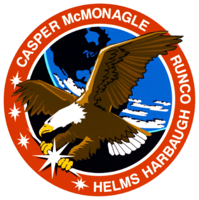STS-54
 | |
| Dane misji | |
| Indeks COSPAR | 1993-003A |
|---|---|
| Zaangażowani | |
| Oznaczenie kodowe | STS-54 |
| Pojazd | |
| Wahadłowiec | |
| Załoga | |
 L-P: Mario Runco, Jr., John H. Casper, Donald R. McMonagle, Susan J. Helms i Gregory J. Harbaugh. | |
| Dowódca | |
| Start | |
| Miejsce startu | Stany Zjednoczone, KSC, LC39-B |
| Początek misji | 13 stycznia 1993, 13:59:30 UTC |
| Orbita okołoziemska | |
| Apogeum | 309 km |
| Perygeum | 302 km |
| Okres orbitalny | 90,6 min |
| Inklinacja orbity | 28,5° |
| Lądowanie | |
| Miejsce lądowania | KSC, Pas startowy 33 |
| Lądowanie | 19 stycznia 1993, 13:37:47 UTC |
| Czas trwania misji | 5 dni 23 godz, 38 min, 17 sek |
| Przebyta odległość | 4 025 415 km[1] |
| Liczba okrążeń Ziemi | 96[1] |
| Program lotów wahadłowców | |
STS-54 (ang. Space Transportation System) – trzecia misja wahadłowca kosmicznego Endeavour i pięćdziesiąta trzecia programu lotów wahadłowców[2].
Załoga
- John Casper (2)*, dowódca
- Donald McMonagle (2), pilot
- Mario Runco (2), specjalista misji 3
- Gregory Harbaugh (2), specjalista misji 1
- Susan Helms (1), specjalista misji 2
- *(liczba w nawiasie oznacza liczbę lotów odbytych przez każdego z astronautów)
Parametry misji
- źródło[1]
- Masa:
- startowa orbitera: 117 600 kg
- lądującego orbitera: 89 708 kg
- ładunku: 21 156 kg
- Perygeum: 302 km
- Apogeum: 309 km
- Inklinacja: 28,5°
- Okres orbitalny: 90,6 min
Cel misji
Umieszczenie na orbicie satelity telekomunikacyjnego TDRS-6[2].
Spacer kosmiczny
- źródło[2]
- EVA – G. Harbaugh i M. Runco
- Początek EVA : 17 stycznia 1993
- Koniec EVA : 17 stycznia 1993
- Łączny czas trwania: 4 godziny 28 minut
- Koniec EVA : 17 stycznia 1993
Zobacz też
Przypisy
- ↑ a b c Mark Wade: STS-54. [w:] Encyclopedia Astronautica [on-line]. [dostęp 2017-07-25]. (ang.).
- ↑ a b c d Tomáš Přibyl: Dzień, w którym nie wróciła COLUMBIA. Bielsko-Biała: Wydawnictwo >DEBIT<, s. 167. ISBN 83-7167-224-1.
- ↑ Robert Godwin: Space Shuttle. Warszawa: Prószyński Media Sp. z o.o., 2011, s. 67, seria: Historia podboju Kosmosu. ISBN 978-83-7648-973-5.
Linki zewnętrzne
- podsumowanie misji STS-54 na stronie KSC (ang.)
- Mark Wade: STS-54. [w:] Encyclopedia Astronautica [on-line]. [dostęp 2017-07-25]. (ang.).
- Spaceflight mission report: STS-54. Spacefacts. [dostęp 2017-07-25]. (ang.).
Media użyte na tej stronie
The flag of Navassa Island is simply the United States flag. It does not have a "local" flag or "unofficial" flag; it is an uninhabited island. The version with a profile view was based on Flags of the World and as a fictional design has no status warranting a place on any Wiki. It was made up by a random person with no connection to the island, it has never flown on the island, and it has never received any sort of recognition or validation by any authority. The person quoted on that page has no authority to bestow a flag, "unofficial" or otherwise, on the island.
STS-54 Mission Insignia
Astronauts pictured in the STS-54 crew portrait from left to right are: Mario Runco, Jr., mission specialist; John H. Casper, commander; Donald R. McMonagle, pilot; and mission specialists Susan J. Helms, and Gregory J. Harbaugh. Launched aboard the Space Shuttle Endeavour on January 13, 1993 at 8:59:30 am (EST), the crew deployed the fifth Tracking and Data Relay Satellite (TDRS-6).


